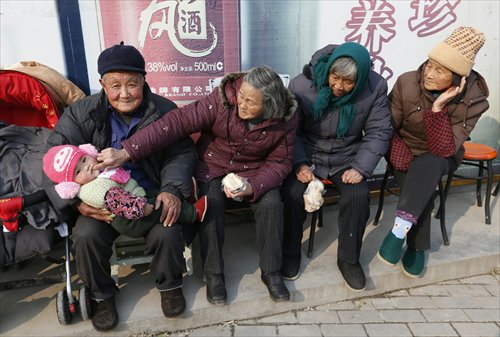China facing serious aging issue: report
Working-age population set to drop 10% by 2040

Three elderly women look at a baby that an elderly man holds in his arms. Photo: CFP
China is facing an aging population, which presents pressing challenges, the World Bank said in a report released Wednesday.
By 2040, the number of working-age adults in China may have fallen by more than 10 percent, which would translate into a net loss of 90 million workers, the bank said in its report on the issue of aging in the East Asia and Pacific region.
"Rapid aging in East Asia is partly a result of the region's fast pace of economic development in recent decades," Sudhir Shetty, World Bank chief economist for the East Asia and Pacific region, said Wednesday at a briefing in Beijing.
Higher incomes and better education have led to steady increases in life expectancy, and have been accompanied by sharp declines in fertility rates, with an increasing number of countries now well below replacement levels, Shetty noted.
China has also seen a decline in the fertility rate and an increase in life expectancy, which poses various challenges under the current economic environment, experts noted.
The direct outcome of an aging popluation is a decrease in the workforce, which will have a limited effect on the growth of China's economy as future growth will come more from productivity gains than from population dividend, said Chen Qiulin, a research fellow at the Institution of Population and Labor Economics of the Chinese Academy of Social Sciences.
But the rapid pace of aging in China raises economic and fiscal pressures, Chen told the Global Times on Thursday, noting that greater access to social insurance funds will be needed, which may require a rise in taxes or less investment in other sectors in order to pay for it.
Chen said the aging population would also put "growing pressure on families, which could possibly change the domestic consumption structure."
In order to boost the country's fertility rate, the government rolled out a policy in October allowing all couples to have a second child.
However, this policy "will not significantly raise the fertility rate in China because, according to our research, only one-fourth of the interviewees we spoke to were willing to have a second child due to the high costs involved," Philip O'Keefe, lead author of the World Bank report, said Wednesday at the same meeting.
As China is facing such a significant challenge from its aging society, the government should unveil policies to adapt to the situation, said O'Keefe.
A range of pressing reforms need to be carried out, according to the report. For instance, in the labor market, China could remove incentives in pension systems that encourage some workers, especially female city residents, to retire too early.
The report also said that developing countries in East Asia should take steps to reform their existing pension schemes.
"This year the Chinese government faces pension deficits, meaning that contributions will be insufficient to meet the pensions that are to be paid out. Canceling the [early retirement] incentives could help ease the burden on pension systems and make better use of the domestic labor force," said Ma Li, director of the China Population and Development Research Center, a think tank associated with China's National Health and Family Planning Commission.
Raising the retirement age could also help make up for the lower working population in the future, Ma told the Global Times on Wednesday, adding that doing more to tap the potential of the existing labor force would be more effective than trying to raise the fertility rate.
Lifting the retirement age to 65 years could effectively provide China with "around 100 million more workers by 2045," Ma said.
The Chinese government is currently planning a progressive approach to lifting the retirement age, the Ministry of Human Resources and Social Security said on November 20. The current retirement age is 60 for men, 55 for female white-collar workers and 50 for female blue-collar workers.
China also needs to keep improving the quality of its workforce by strengthening education and promoting continued learning, according to Chen.